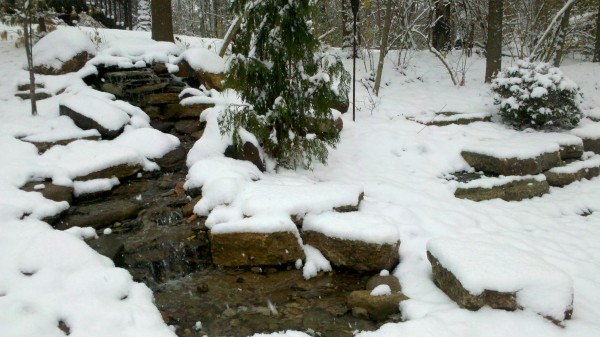Common questions for Pond Owners during the winter months

Helping Your Customers through Winter Just because Old Man Winter has arrived doesn’t necessarily mean your phone stops ringing. Some of your newer customers are sure to be concerned with the safety of their fish as they watch the surface of the pond start to freeze over. They may call you more than once just to make sure their pet koi “Goldie” is okay in the icy water … especially when they see her hanging out at the bottom of the pond, somewhat motionless.
Just because Old Man Winter has arrived doesn’t necessarily mean your phone stops ringing. Some of your newer customers are sure to be concerned with the safety of their fish as they watch the surface of the pond start to freeze over. They may call you more than once just to make sure their pet koi “Goldie” is okay in the icy water … especially when they see her hanging out at the bottom of the pond, somewhat motionless.
Patient answers to frantic questions will help assure that yes, as long as they follow a few smart guidelines, Goldie will be back in the spring, happily gliding in and out of the waterlilies. Following are some of the more frequently asked questions you might find yourself fielding from your pond customers during the winter months.
Can a pond run throughout the winter?
Yes, although maintenance is usually the determining factor in whether or not a pond owner keeps their pump and waterfalls running in the winter. The primary maintenance responsibility at this time is to make sure there is enough water for the pump to operate properly.
During the winter months, the usual water supply options are not available. Outdoor water spigots and automatic water fill valves should be turned off to prevent pipes from freezing and cracking. Therefore, pond owners who run their systems during the winter will need to find an alternate water source to replenish their pond.
Water can be supplied from a hose run from inside the house or by making multiple trips with a five-gallon bucket. Generally speaking, it’s not uncommon to have to go out a few times a month during the winter to top off the pond, as water will evaporate slowly.
Won’t the waterfall freeze solid?
Pump size is important when determining a waterfall’s ability to operate during the winter. A pump that provides at least 2,000 gph can be operated throughout the winter without a problem, as long as it runs continuously. Moving water will usually keep a hole open in the ice around the waterfalls and in front of the circulation system.
However, repeated days in sub-zero temperatures may lead to excessive ice build-up and can cause the system to operate improperly. If the flow of water into the circulation system is unable to keep up with the pump because of ice build-up, it may be necessary to shut the system down. The system can be run again once the ice is melted and normal water flow is restored.
Will the filters and pipes crack?
Most good filters are constructed out of rotational-molded polyethylene, and are designed to bow and bend with the freezing and thawing effects of winter. The PVC flex pipe is reinforced and will not crack unless water is left in the pipe over the winter and allowed to freeze. If your customer decides to keep the pump running all winter long, there will still be a constant flow of water traveling through the pipe and the moving water will not freeze. If your customer decides to turn the system off for the winter, most of the water in the pipe will drain back into the pond when the circulation system is removed.
What should be done with the pump once the system is shut down?
Remove the pump from the system and store it in a frost-free location, ideally submerged in a bucket of water. The water around the pump housing will prevent the seals on the pump from drying and cracking. Since most submersible pumps are oil-filled, it is not suggested to let them freeze solid.
To extend the life of the pump, clear the impeller shaft free of any debris before winter storage. It is also beneficial to spin the impeller a couple of turns by hand before turning it on in the spring. This prevents any corrosion or debris from seizing the impeller and interrupting proper pump function.
What about the filter?
When preparing the pond for winter, remove the filtration media and rinse it down. It is recommended to store any such media in a frost-fee location like a garage or shed. If left over the winter, all of the filtration media may freeze into a solid block, causing unnecessary delays during spring clean-out.
Will the fish be okay?
Ornamental fish will do just fine in two feet of water, as long as some form of aeration is provided, and a hole is kept in the ice to allow the escape of harmful gases. It’s recommended to place the waterfall pump in a basket, bucket, or pump sock and surround the intake of the pump with stones to prevent clogging. Place the pump on the second or third shelf of the pond so the surface water is broken by the aeration. The agitation from the pump will prevent freezing and provide oxygen.
Another option is to use an Aquascape Pond De-icer in combination with a small submersible pump (at least 150 gph) such as the AquaForce®. You can place the AquaForce® on the first shelf of the pond, bubbling at least one inch above the surface. While floating heaters are the most common method of keeping a hole open in the ice, they won’t provide oxygen for the fish.
The Bottom Line
The bottom line for winterization is maintenance. Roughly 70 percent of pond owners in the colder climates decide to shut down their system because they don’t enjoy tending to their water garden during the bitter months of the winter. The aesthetic rewards of the winter pond are absolutely worthwhile, however. So by all means; don’t be afraid to encourage customers to keep the system running as long as possible. Shutting down a pond during winter is the popular option. Just be sure to help your customers take precautionary measures to preserve fish, plant and pump life.
